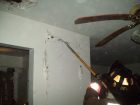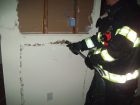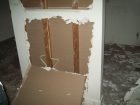
Features
Structural
Training
Back to Basics: The right way to overhaul
We are continuing with a look back over the last 10 years with articles that have been a highlight based on the topic or feedback. This article was published in August 2009 and was a highlight because of the topic: not much is discussed about overhaul.
March 2, 2018
By Mark van der Feyst
■ The right way to overhaul: August 2009
In the fire service, we have many different terms associated with our operations. One of them is truck company operations. What exactly does this term mean? In the Canadian fire service, we rarely use this term, but we involve ourselves within the operations that are associated with it. Truck companies are fire apparatus that have ladders, both ground and aerial, and they do not have the capability to pump water. They are a giant toolbox on wheels. Firefighters who run on truck companies are usually the seasoned veterans. This is because of the nature of work that is performed by them. There are 10 functions that a truck company will be responsible for: rescue, ventilation, forcible entry, reconnaissance, laddering, overhaul, elevated master streams, salvage, utility control and RIT.
Even though we do not operate in Canada with official truck companies — we usually call them aerials or quints — we still perform these functions using the apparatus that we do have. Every apparatus has ground ladders, equipment for rescue, equipment for salvage and overhaul, equipment for forcible entry; quints and aerials have elevated master streams and provide elevated access.
I want us to consider the basic task of overhaul. Overhaul is often overlooked and never trained upon. It is always an afterthought at most fire ground operations. When we think of overhaul, we usually associate it with creating giant holes in walls and ceilings to find hidden fire. The home owner is usually shocked when they find their house’s interior all opened up.
I can remember one time when riding along with a fire department down in Maryland, we had a kitchen fire in a residence. The fire was quickly knocked down and the truck company began their overhaul operations. Instead of feeling and looking for hidden fire, they decided to gut the entire kitchen and main floor. The home owner was angry at the amount of damage that we created for no real reason except to overhaul.
A firefighter friend of mine who works in Denver was telling us about a captain that made his firefighters cut nice neat, square holes with drywall saws to find the hidden fire and then made them carry all the debris outside into a neat pile. The end result was the home owner was happy and appreciative of the care that was taken to ensure the least amount of damage. The idea behind the square holes was that when it came time to fix the walls, it is easier to fix them with square holes created versus giant holes made with Halligans or axes. The home owner in this story was the firefighter friend of mine and it was his house.
So, what is the point of the above-mentioned stories? Let us go back to the basics of overhaul. We can make square, neat holes in our walls and ceilings without having to use drywall saws. We can still use our Halligans and hooks to accomplish the same task. In Photo 1, we can see an outline of a square hole created by a Halligan tool that will be soon opened. Notice the perforation marks all the way around. These have been made with the fork end of the Halligan. This provides a template for the drywall to be pulled off in a square pattern.
In Photo 2, we are ready to pull the drywall away from the studs. The firefighter uses the adz end of the Halligan to pry the drywall away from the studs. The end result is seen in Photo 3, a nice square opening allowing us to see behind the drywall.
We still need to use our other tools such as thermal imaging cameras, heat guns and touch to determine where our holes need to be created. Just arbitrarily opening up walls and ceilings near a fire area will not suffice. We need to ensure that there is heat behind the wall first before we open it up. Thermal cameras and heat guns are a great tool for determining heat build-up behind walls and ceilings. Using your hand to touch and feel the wall also works.
So why is it important to use these simple techniques when conducting overhaul? First, it helps with our customer service. If home owners witness us taking the time and effort to care for their house by creating nice square openings where needed, they will appreciate the fire service all the more. It is not as intrusive to them as it would be if we are demolishing their entire kitchen and main floor for a small kitchen fire. Secondly, it helps with the investigation of the fire. Many investigators will tell you that the worse thing to do is take away all of the drywall. If it has to be done, then so be it, but if it can be avoided, this will help with their investigation. Burn patterns on walls and ceiling tell a story and point the investigator to the cause and origin of the fire. No walls or ceilings means no story for the investigator.
Whenever a chance arises to use an acquired structure for training, practice this technique and become familiar with it. If no access to acquired structures is available, then build a wall prop four feet high and eight feet long and nail sheets of drywall to it. The more we practice these basic techniques, the more we will increase our mastery of skills.
Mark van der Feyst has been a member of the fire service since 1999 and is a full-time firefighter in Ontario. Mark teaches in Canada, United States and India, and is a FDIC Instructor. He is the lead author of the Residential Fire Rescue book. Email Mark at Mark@FireStarTraining.com
Print this page
Advertisement
- Leadership Forum: The great shirt debate
- Dozer Boss: How firefighters are using bulldozers to combat wildfires


